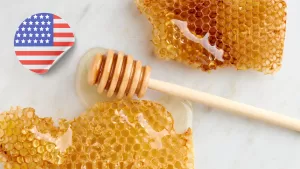The Giant Honey Bee, scientifically known as Apis dorsata, is a remarkable species native to South and Southeast Asia. Known for its impressive size, bold temperament, and incredible honey-producing capabilities, this bee plays a crucial role in the ecosystem and supports human livelihoods. Despite its importance, the Giant Honey Bee remains relatively unknown outside the circles of beekeepers and honey enthusiasts. In this blog, we’ll explore the fascinating world of Apis dorsata, delving into its habitat, behavior, honey production, and the conservation efforts needed to protect this extraordinary species.
Table of Contents
ToggleWhat Makes the Giant Honey Bee Unique?
The Giant Honey Bee stands out due to its size, with worker bees measuring between 17-20 millimeters—almost double that of the common Western honey bee. This species is known for its defensive and aggressive behavior, which makes harvesting honey from its wild hives quite dangerous. However, this fearless nature is also vital for the protection of their colonies from predators, contributing to their survival in harsh environments.
Apis dorsata typically constructs large, single-comb hives in open spaces, preferring the undersides of tree branches, cliff faces, or even human-made structures. Unlike domesticated honey bees, these wild bees maintain a nomadic lifestyle, moving to different locations based on seasonal changes and resource availability. This mobility makes them crucial pollinators in tropical and subtropical forests across Asia, where they help maintain biodiversity.
Habitat and Distribution
The Giant Honey Bee is native to the tropical and subtropical regions of South and Southeast Asia, particularly found in countries such as India, Nepal, Thailand, Indonesia, and the Philippines. These bees thrive in warm, forested areas, but have also been observed nesting in urban settings where food sources are abundant.
Their hives are often built in high, hard-to-reach locations, which helps deter predators and minimize human interference. Despite their preference for these remote areas, honey hunting remains a common practice in many regions. Ensuring that this is done sustainably is critical to preserving both the species and its natural habitat.
The Role of Apis dorsata in Honey Production
A defining feature of the Giant Honey Bee is its impressive honey production. Some colonies produce up to 50 kilograms of honey in a single season, making them highly sought after by local honey hunters. In regions like Nepal, the traditional practice of honey hunting has been passed down through generations, with hunters scaling cliffs to harvest honey from wild hives.
The honey produced by Apis dorsata is commonly referred to as “wild honey.” Due to the variety of plants these bees forage on, the honey has a unique flavor profile and is valued for its medicinal properties. In addition to honey, these bees also produce beeswax, bee pollen, and propolis, all of which are used in traditional medicine and cosmetics.
However, overharvesting presents a significant threat to the sustainability of these wild bee populations. Sustainable honey farming practices are crucial to ensure that the colonies can recover and continue thriving without being overexploited.
Giant Honey Bee Behavior
The behavior of Apis dorsata is one of the primary reasons for their survival in the wild. These bees live in large colonies that can house up to 100,000 individuals. One of their most remarkable defense mechanisms is the “bee curtain,” a synchronized movement where the bees move their abdomens in a wave-like pattern to ward off predators. This collective action is particularly effective against birds and other large enemies.
Apis dorsata also exhibits migratory behavior. The colonies relocate periodically based on resource availability and environmental conditions. This nomadic pattern is essential for their survival, as it allows the bees to access fresh sources of nectar and pollen while avoiding areas that have been depleted.
Pollination and Ecological Importance
Beyond honey production, the Giant Honey Bee is a vital pollinator. As it forages on a diverse range of flowers, it aids in the pollination of countless plant species, many of which are crucial to the health of tropical and subtropical ecosystems. This pollination service helps maintain biodiversity, supporting the growth of plants that serve as food sources for a variety of animals.
Their role in agriculture is also significant. Farmers in Asia depend on wild bee species like Apis dorsata to pollinate crops such as mangoes, melons, and other fruits. The decline of these pollinator populations could have severe consequences, affecting both natural ecosystems and agricultural productivity.
Challenges and Threats to Apis dorsata
Despite their resilience, the Giant Honey Bee faces several threats that could jeopardize their populations. One of the most pressing issues is habitat loss, driven by deforestation for agriculture, urbanization, and infrastructure development. As forests are cleared, these bees lose the habitats they depend on for nesting and foraging.
Climate change further exacerbates these challenges. Rising temperatures and shifting weather patterns disrupt the migratory behavior of Apis dorsata, affecting their ability to find suitable nesting sites and food sources. Pesticide use in agricultural areas also poses a significant risk to these bees, as harmful chemicals can damage their colonies and reduce their numbers.
The practice of honey hunting, while culturally significant in many regions, can also be detrimental if not managed sustainably. Overharvesting can deplete bee populations, reduce pollination services, and destabilize local ecosystems.
Conservation Efforts and the Future of Apis dorsata
Efforts to conserve the Giant Honey Bee are crucial to protect this species and the ecological services it provides. Several initiatives focus on habitat preservation through reforestation and the establishment of protected areas. Educating local communities on sustainable honey harvesting practices is another key aspect of conservation, as it ensures that honey can be collected without endangering the bee populations.
Research into the behavior and migration patterns of Apis dorsata is also essential for understanding how climate change and habitat destruction are impacting the species. This knowledge will help inform conservation strategies to protect them in the long term.
In some countries, governments and environmental organizations are promoting bee-friendly agricultural practices that encourage farmers to reduce pesticide use and cultivate more pollinator-friendly plants. These efforts are essential to support not only the survival of Apis dorsata but also the broader ecosystem services they provide.
Conclusion
The Giant Honey Bee (Apis dorsata) is an extraordinary species that plays a critical role in the ecosystems of South and Southeast Asia. From honey production to pollination, these bees contribute in many ways to both the environment and human societies. However, they face significant threats, including habitat loss, climate change, and unsustainable honey harvesting practices.
Protecting this species requires a combination of conservation efforts, sustainable beekeeping practices, and environmental stewardship. By taking these steps, we can ensure that future generations continue to benefit from the essential services provided by Apis dorsata and other wild bee species.



